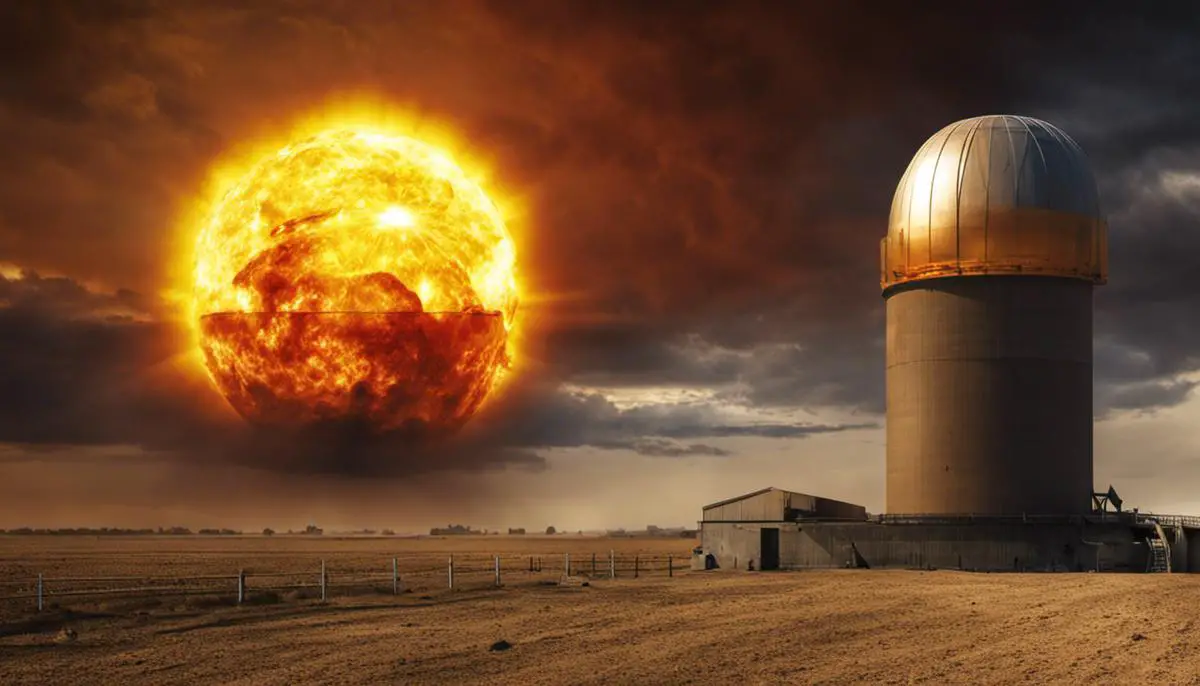Imagine detonating a nuclear weapon on the Sun, a celestial object that’s over one million times larger than our Earth, incredibly hot, operates with tremendous pressure, and is already a natural nuclear reactor converting hydrogen into helium through fusion. Understanding such a scenario not only requires us to comprehend the magnitude of nuclear weapons but also the complex physics of the Sun—how it was formed, its size, composition, and how it produces vast amounts of energy. As we journey through this exploration, we will delve into nuclear fusion, reactions, and the hypothetical impacts and consequences of such an unprecedented action.
Understanding Nuclear Weapons and the Sun
Understanding the Basics: Nuclear Weapons and the Sun
Nuclear weapons derive their destructive power from a combination of kinetic energy, radiation, and heat energy. They work by triggering a chain reaction that splits the atoms of certain isotopes like uranium-235 or plutonium-239, which releases vast amounts of energy. This release is what causes the massive explosion, producing a temporary, extremely hot and bright area of energy known as a fireball.
On the other hand, the Sun is colossal compared to Earth. Its diameter is about 109 times larger than Earth’s, and it constitutes about 99.86% of the total mass of the solar system. The Sun is primarily composed of hydrogen (about 70%) and helium (about 28%), with traces of other heavier elements.
Interestingly, the Sun itself is a giant nuclear reactor, spreading energy through a process known as nuclear fusion. This occurs at the Sun’s core where the temperature is extremely hot, reaching millions of degrees. Under such intense heat and pressure, hydrogen atoms combine to form helium in a continual process. This fusion reaction releases tremendous amounts of energy in the form of heat and light — the very heat and light that sustains life on Earth.
Picturing the Consequence: Launching a Nuclear Weapon at the Sun
Contemplating the aftermath of launching a nuclear bomb at the Sun, in theory, is indeed intriguing. However, due to the colossal size and thermonuclear nature of the Sun, the actual impact would be virtually insignificant. To start with, the size difference is staggering. Comparing even the most potent nuclear bomb ever ignited on Earth with the Sun is like comparing a speck of dust to a mountain. On top of that, the amount of energy discharged by the Sun is overwhelmingly more substantial than that discharged by any nuclear weapon.
Take, for example, the hydrogen bomb, the most robust nuclear device to date. It can release energy equating to millions of tons of TNT. Yet, the Sun can outshine this by discharging energy equivalent to billions of hydrogen bombs every single second. As a result, any hypothetical nuclear explosion would be meager in comparison, swallowed up by the Sun’s energy without causing any noteworthy disarray or alteration.
Adding to this, the Sun’s gravitational pull is incredibly powerful. If a nuclear weapon could ever reach the Sun – which is a scientific triumph in itself – its gravity would rapidly pull the weapon towards its core, neutralizing any potential devastation before it could create any significant impact.
In summary, if we were ever able to detonate a nuclear bomb on the Sun, the event would, in essence, be invisible, and the Sun would continue operating as if nothing happened. It is crucial to mention, though, that using a nuclear weapon on the Sun serves no scientific or geopolitical purpose, and it would be indisputably reckless and wasteful. Launching nuclear weapons into space could solicit a host of technical difficulties and geopolitical issues, which is why international laws and treaties strictly prohibit such conduct.
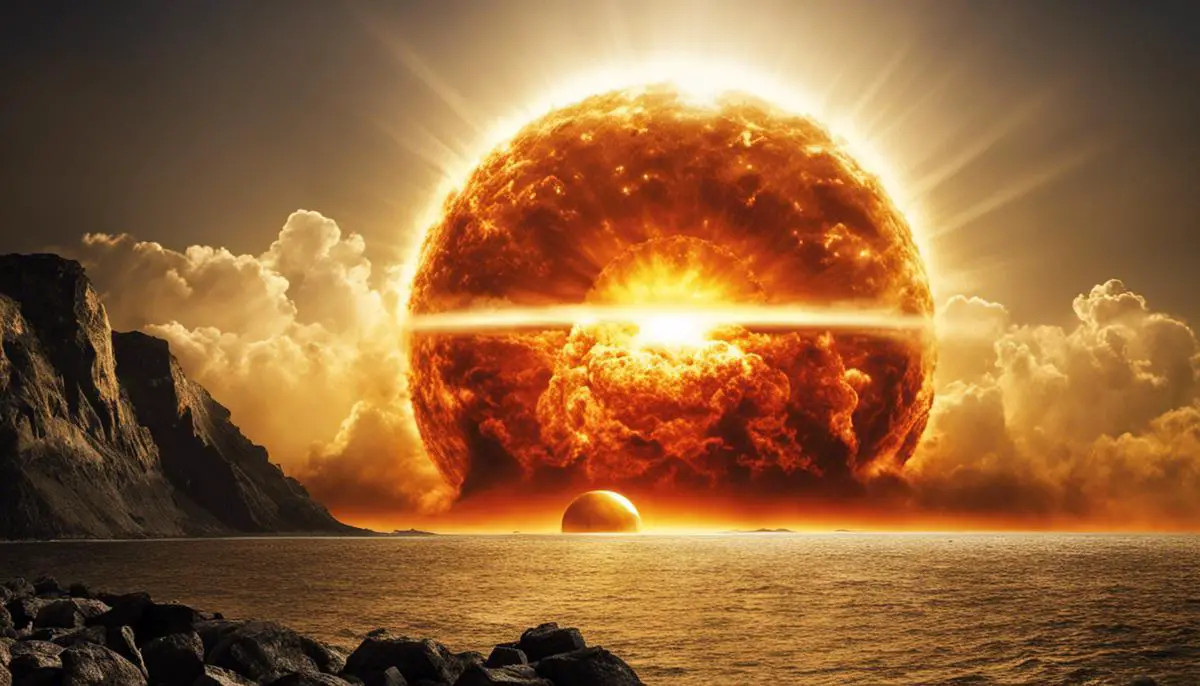
Physics of Nuking the Sun
Appreciating the Sun’s Extraordinary Nature
Our Sun, the solitary star serving our solar system, is a radiant globe of blazing, luminous gases. Its core can reach temperatures as high as 15 million degrees Celsius, while the surface amasses around 5,500 degrees Celsius. The Sun’s core is the site of nuclear fusion, an impressive process that turns hydrogen into helium, thus releasing copious amounts of energy. This energy powers not only the Sun itself but is also what makes life as we know it on Earth possible. It’s important to comprehend that these conditions are unimaginably harsh and far outstretch what is manmade.
The Scale of a Nuclear Bomb Compared to the Sun
To compare the immense scale and energy of the sun, the energy release from a nuclear bomb is minuscule. In fact, every second, the Sun releases energy equivalent to billions upon billions of nuclear bombs. The largest nuclear bomb ever detonated by humans is the Tsar Bomba by the Soviet Union, with a yield of about 50 megatons of TNT. To put this in perspective, every single second, the Sun produces energy equivalent to billions of Tsar Bombas.
The Scenario: Detonating a Nuclear Bomb on the Sun
If a nuclear bomb were somehow launched and detonated on the Sun, it’s doubtful it would even be noticed. The explosion would be absorbed by the Sun’s vast and intense heat and gravitational forces. Given the Sun’s size and high temperatures, any relatively minute nuclear blast would be merely absorbed and dissipated.
Nuclear Fusion: The Heart of the Sun
Our Sun, like all stars, sustains itself through nuclear fusion – a process where hydrogen atoms merge to create helium. This process results in energy being released in the form of light and heat. A nuclear bomb also releases its energy via a process called nuclear fission, where atoms are split rather than fused together. However, the energy of a nuclear bomb is trivial compared to the Sun’s constant fusion process. Any additional nuclear reaction from the bomb, such as the fusion of hydrogen into helium, would likely be unnoticed amidst the Sun’s constant energy output.
The Effect of Gravity on the Nuclear Bomb
The Sun’s intense gravity would also play a role in this scenario. As soon as the bomb entered the Sun’s gravitational field, it would start to speed up. By the time it reached the Sun’s surface, it would be moving so fast that the bomb would penetrate deep into the Sun’s interior before detonating. This means the bomb’s impact would be dispersed throughout a larger volume of solar material, further diminishing any potential effect.
Summarizing the Effect: A Needle in a Haystack
When considering the Sun’s enormous energy output from constant nuclear fusion, the extreme temperatures it houses, and the intense gravitational force it exerts, it becomes clear that the detonation of a nuclear bomb would be like a needle losing itself in a haystack. The overall influence of such an event would be negligible at best and definitely would not induce any noticeable alterations in the Sun or pose any risk towards Earth.
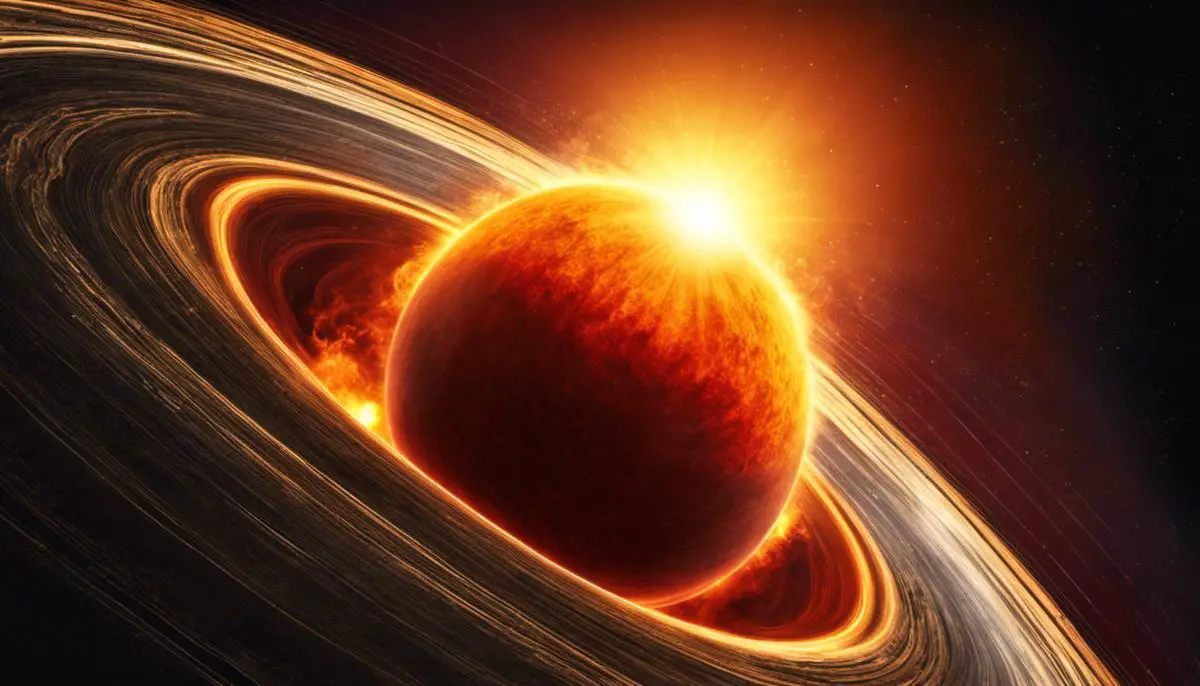
Hypothetical Immediate Impact
Detailed Analysis: Sizing Up the Immediate Effect of a Nuclear Detonation on the Sun
To truly understand the immediate effect of a hypothetical nuclear detonation on the Sun, we need to first familiarize ourselves with some basic properties of both the Sun and nuclear bombs. The Sun accounts for 99.86% of the all mass contained in our solar system and can be viewed as a blazing ball of plasma, the core of which harbors temperatures estimated to be around 15 million degrees Celsius. In contrast, the strongest nuclear bomb ever detonated carried a total yield of 50 megatons.
Considering the Sun’s substantial mass and herculean energy compared to that of a solitary nuclear bomb, the immediate effect of such a blast would likely be close to nothing. The sun is always in a state of nuclear fusion, where hydrogen atoms merge to create helium, in the process liberating vast quantities of heat and light. The energy from a single nuclear bomb, therefore, would likely get absorbed and dispersed swiftly within this environment.
Impact on the Sun’s Activity
Assuming our technology could deliver a nuclear weapon to the Sun, the explosion’s impact would be minuscule compared to the total energy the Sun generates through nuclear fusion. Nuclear bombs operate on the principle of nuclear fission where large, unstable atomic nuclei are split into smaller components, releasing energy in the process. The Sun, however, operates on fusion, which generates far more energy. Essentially, the Sun is constantly performing a more gargantuan version of a nuclear explosion on its own.
Impact on Solar Wind or Solar Flares
Solar winds and solar flares are significant phenomena occurring because of the Sun’s intense nuclear fusion activity. Solar winds comprise charged particles that the Sun throws out into the solar system, while solar flares are sudden, intense releases of electromagnetic energy. As such, the detonation of a nuclear weapon, considering its comparatively small energy output, would likely not make a significant impact on either solar wind or solar flare activity.
The impact would be barely perceptible given the Sun’s massive and constant flow of energy. Therefore, the Earth would not feel any major shockwaves or radiation fallout from such an action. The size and scope of a nuclear bomb’s impact are simply dwarfed by the sheer scale and ongoing nuclear activity of the Sun.
The Sun vs. Our Nuclear Arsenal
Theoretically, if a detonation were to cause a chain reaction, it could possibly destabilize the Sun. This could lead to increases in solar flare activity, higher rates of solar wastage, or in the most extreme case, a supernova. However, such a scenario is purely hypothetical. It would necessitate a colossal number of nuclear bombs, exponentially more than our current arsenal. Additionally, it would require an intimate and precise understanding of the Sun’s internal workings, knowledge which we do not have at present. Therefore, we can rest easy knowing that our nuclear endeavors pose no threat to the Sun for the time being.
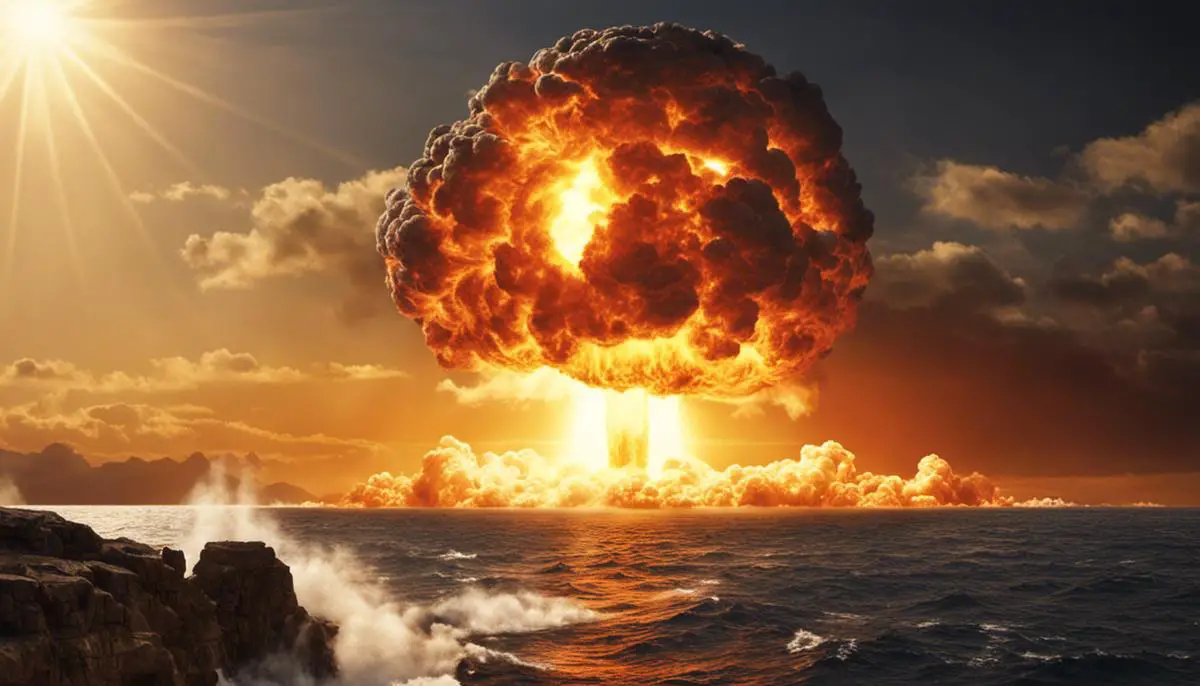
Potential Long-term Consequences
The Underwhelming Physics of Nuking the Sun
From a physics standpoint, any attempt to nuke the Sun would likely have extremely minimal impacts, almost to the point of insignificance. The Sun itself essentially operates as a gargantuan nuclear fusion reactor, tirelessly transforming hydrogen into helium and releasing an overwhelming amount of energy as it does so. It’s critical to realize that every second, the Sun generates energy equivalent to millions of 100-megaton nuclear bombs. Against such power, an additional nuclear bomb would be like introducing a single drop of water to the vastness of an ocean. Furthermore, the intense heat of the Sun would vaporize any bomb or projectile long before it even reached the solar core.
Solar System Impacts:
Although a nuclear bomb would be insignificant compared to the Sun’s size and energy, it might still cause disruption depending on its composition or payload. Theoretically, should the weapon contain something that alters the Sun’s fusion processes or injects significant mass, it could disrupt normal solar activities with unforeseen consequences. This could potentially result in an altered solar output which may disrupt the balance of our solar system; however, this is largely speculative and the result would most likely be negligible given our current nuclear capabilities.
Impact on Earth’s Life:
If, by some extraordinary chance, a nuclear bomb were to cause significantly altered solar output, it could drastically impact the Earth’s climate. Our planet’s temperature and weather patterns are extremely sensitive to changes in solar radiation. Massive enough changes could trigger ice ages or wildfires, causing widespread extinction events. Even a short period of an exceedingly bright or dim Sun could cause irreversible damage. However, this scenario is highly improbable given that the energy release from our most powerful nuclear weapons does not even come close to matching the Sun’s regular output.
Scientific Opinions and Theories:
Scientific consensus largely dismisses the idea of nuking the Sun given our current technological abilities and understanding of nuclear weapons and solar physics. Scientists like Neil deGrasse Tyson have publically stated that the concept is fundamentally flawed as it underestimates the ongoing titanic nuclear fusion already happening within the Sun. Furthermore, the potential for unforeseen consequences, although highly unlikely to cause any significant impact, makes it a hazardous and unwarranted undertaking. Thus, the focus of the scientific community continues to be on the use of nuclear energy for space exploration and related purposes rather than interstellar destruction.
Considering the Legal and Ethical Constraints:
Discussion of deploying a nuclear weapon, regardless of where, raises immediate ethical concerns and is subject to strict international regulations. Notably, the Outer Space Treaty of 1967, ratified by a majority of global nations, explicitly forbids any militaristic activity on celestial bodies, including the Sun. Therefore, setting off a nuclear device on the Sun would not only be scientifically unlikely, but also a clear transgression of international law and ethical norms.

Scientific Consensus & Alternatives
Understanding the Scientific Perspective:
In the realm of science, leading consensus indicates that any explosion, even one as powerful as a nuclear detonation, would create negligible effects if conducted on the Sun. The Sun is a vast and extraordinarily energetic entity that is continuously undergoing nuclear fusion deep within its core. The energy involved in this process puts to shame the power produced by any human-made weapon. To put into perspective, the explosion of a bomb as devastating as the one unleashed on Hiroshima would be the equivalent of introducing a droplet of water into the vast expanse of the Ocean when compared to the Sun’s relentless fusion process.
Probable Risks of Nuking the Sun
Although nuking the Sun would have little practical impact, risks involved in the process itself cannot be overlooked. Efforts to deploy a nuclear weapon towards the Sun could lead to catastrophic outcomes if something went wrong. We risk detonating the weapon prematurely within the Earth’s atmosphere or on our lunar satellite, generating immediate devastation. Furthermore, the use of nuclear weapons in space also violates international treaties, potentially causing international political and diplomatic strife.Moral Considerations
More importantly, the idea of detonating a weapon on the Sun, or any other celestial body, introduces various moral and ethical concerns. This line of thinking may lead us towards a dangerous precedent of viewing outer space as a potential battlefield or dumping ground. It moves against the principles of space exploration, which promotes the peaceful use of space and understanding of the universe for the benefit of all humankind.Alternative Concepts
Instead of contemplating aggressive actions like nuking the Sun, the scientific community proposes more constructive alternatives. Harnessing solar energy, for instance, is a concept that is being extensively researched and developed. The Sun is an abundant source of energy. Advancements in solar energy technology present a more harmonious way of utilizing the Sun’s power, without inflicting destructive tendencies.Another alternative concept is advancing solar probes such as NASA’s Parker Solar Probe
. This probe was launched in 2018 and is making a close approach to the Sun to study the Sun’s outer corona. These solar exploration initiatives lead us to a broader understanding of our solar system and universe, promoting peaceful and insightful study and thereby creating a wealth of knowledge to benefit humankind.Thus, the existing scientific consensus leans heavily against such an idea as nuking the Sun, suggesting more constructive and insightful avenues to explore and leverage our solar system’s central star.
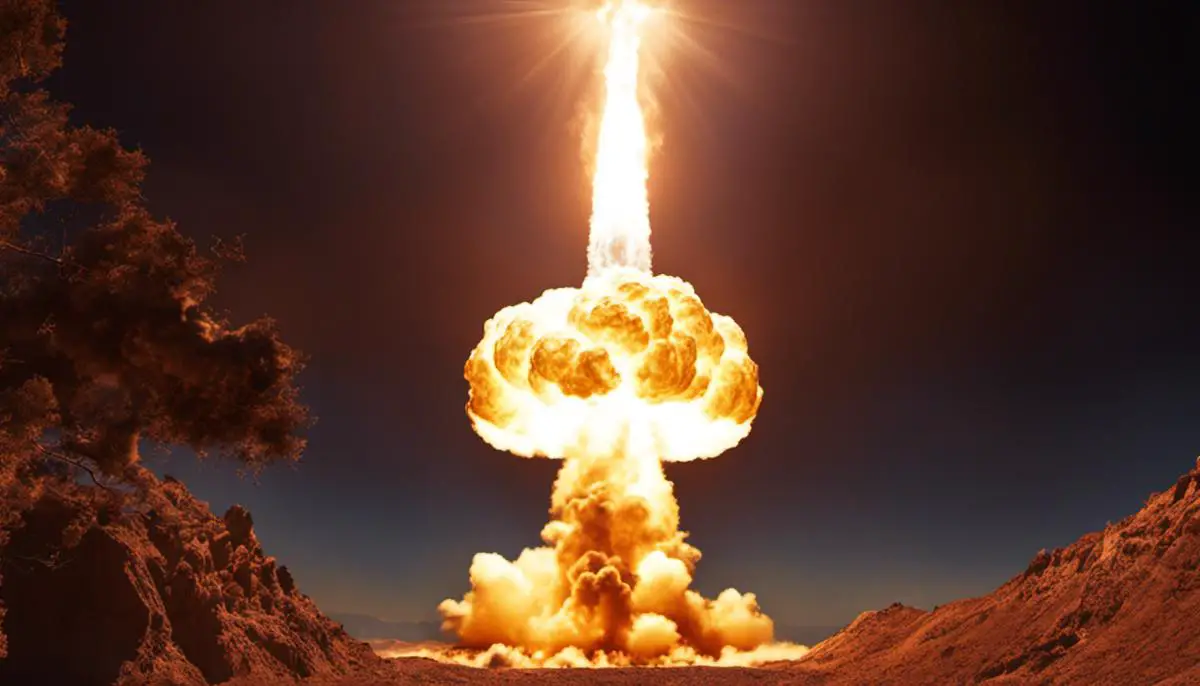
While it’s an intriguing mental exercise to consider nuking the Sun, the scientific consensus tells us it’s a notion fraught with peril, both in terms of practicality and morality. There is more value to be extracted from studying our star, understanding its processes, and harnessing its solar energy sustainably. Ultimately, the Sun is the life-giving engine of our solar system, and the focus of our scientific endeavors should revolve around preservation and co-existence, rather than destruction or alteration.
![]()
